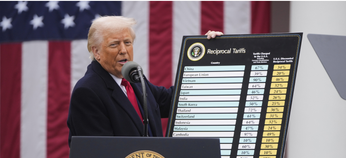
Economic cracks
Hello! In the words of Central Bank governor Elvira Nabiullina, Russia’s economy is undergoing a “structural transformation.” But exactly what this means is unclear: events are moving fast and unpredictably. Our top story this week is the big economic surprise that – after an inflationary shock in March – Russia recorded deflation last month amid a sharp drop in demand. Forced to call an emergency meeting, the Central Bank slashed interest rates by three percentage points. This also helped to stop the strengthening of the ruble, which, at 55 to the U.S. dollar, was starting to jeopardize financial stability.

What’s happening?
The Central Bank announced Wednesday an emergency board meeting for the following day. This kind of extraordinary meeting is very rare, but since the start of the year we’ve already seen two: one after the start of the war at the end of February to raise interest rates to 20 percent, and in early April when the rate was lowered to 17 percent.
The market immediately suspected something was afoot and, sure enough, that evening Rosstat published consumer price data for May 14-20 that showed deflation for the first time since last year. This is a very rare occurrence: if Russia records any deflation, it is invariably in August and September when the harvest pushes down prices for fruit and vegetables. This time, though, prices dropped (albeit by just 0.02 percent) after four-and-a-half months of rapid increases (overall, prices are up 11.8 percent since the start of the year).
Deflation is a sign of reduced demand in the economy. The Economic Development Ministry’s first comments on the Rosstat’s figures explained them as “a continuing slump in consumer activity caused by a decrease in immediate demand and a return to more familiar patterns of consumer spending after several months of citizens buying ‘for the future’.”
But the ruble’s inexorable rise also played an obvious role. Dmitry Polevoy, director of investments at Loko-Invest, suggested that the scale of the currency strengthening “triggered the financial authorities’ pain points”. Economic Development Minister Maxim Reshetnikov described Thursday the current exchange rate as “a problem in the long run”.
Should deflation drag on, manufacturers will start to make a loss, cut investments and staff, leading to unemployment rises that exacerbate an economic slump. This could then lead to a deflationary spiral that might take years to overcome.
Reshetnikov described the situation as a demand crisis, citing data from cash registers that showed a 10 percent drop in consumer spending compared with pre-war levels. According to Sberindex (which details spending on the cards of state-owned lender Sberbank), Russians continue to spend more in annual terms. However, with inflation at 18 percent, this is unsurprising. Meanwhile, demand for some non-food products is already in a deep recession: on May 22, spending on clothes was down 40.9 percent year-on-year, furniture spending was down 23.3 percent, and spending on electronics was down 15.5 percent.
“We could fall into a deflationary spiral where a reduction in the money circulating in the economy leads to reduced productivity, falling prices and so on,” Reshetnikov said Thursday.
The government response
The Central Bank slashed the interest rate by 3 percentage points (to 11 percent) and made clear that it was willing to lower the rate even further at its next meeting on June 10. For example, Polevoy expects another cut of up to 1 percentage point.
The ruble, which had previously ignored both cosmetic and radical attempts to halt its strengthening, responded instantly to the Central Bank’s indication that it was ready to take a decisive stand. A few hours after the extraordinary board meeting was announced, the U.S. dollar gained 5 percent against the ruble and, after Thursday’s interest rate decision, it climbed another 10 percent. In total, from Wednesday morning to Friday evening, the U.S. dollar gained almost 20 percent against the ruble, closing up 11 rubles.
At the same time, the government introduced its own anti-deflation measures, which should boost demand faster than interest rate changes that usually take at least six months months to feed into the economy. Russian President Vladimir Putin unveiled Wednesday an 10 percent indexation of pensions, minimum wages and the poverty line. This neutralizes the impact of inflation for unwaged pensioners and supports incomes for the poorest Russians (many social security payments, such as child benefits, are linked to the poverty line).
Prime Minister Mikhail Mishustin said that indexing social payments will “correct the situation around consumer demand.” However, real earnings (which represent 63.2 percent of the population’s income) will continue to fall – as business activity declines it’s impossible to reverse that trend. While Putin celebrated no sign of rising unemployment, there is no doubt that Russia’s adjustment to the new economic conditions is hitting salaries. Employees are being sent on unpaid leave, or are seeing reductions in pay. So far this year, real salaries are down 3.8 percent and disposable incomes have fallen 6.8 percent.
Unsurprisingly, the Finance Ministry is concerned about increased expenditure. The unscheduled indexation will cost 600 billion rubles ($9.2 billion) in 2022 and a trillion rubles $15.2 billion) in subsequent years, Finance Minister Anton Siluanov said Wednesday, warning that such new responsibilities “should be taken very cautiously”. Siluanov explained his cautiousness by referring to “new tasks, such as restoring the economies of our new territories and ensuring a high level of combat readiness for our army.
Siluanov last month estimated the 2022 budget deficit at a minimum of 1.6 trillion rubles. When asked at the time how big it could get, he said: “It all depends on our response,” and added that there would likely be an anti-crisis package in support of the economy costing about 4 trillion rubles. Within a month, this figure has doubled: Siluanov told journalists Friday that the overall cost of the “budget stimulus” would be 8 trillion rubles.
What’s next?
Russia’s government is confident that oil and gas revenues will prop up the state’s finances. A government source told The Bell that revenue from energy exports are expected to increase in 2022 due to rising prices (despite a decline in the physical amount of exports).
However, the same cannot be said of other sources of revenue, in particular dividends from state companies (the 2022 budget anticipated 693 billion rubles from such dividends). “Obviously, it’s crazy to take 50 percent [of 2021’s profits] from banks. The same applies to many manufacturers. But there are those who will pay,” Deputy Finance Minister Aleksei Moiseyev told journalists Tuesday. According to him, that 50 percent dividend on profits will be decided on a case-by-case basis. In 2020, Sberbank made the biggest payment of all state-owned companies – 211 billion rubles. But the government last month signed off on Sberbank’s non-payment of dividends from shares in 2021.



PAID SUBSCRIPTION LAUNCH
From May 1, 2025, The Bell in English will no longer be free
From May 1, 2025, all The Bell’s newsletters and online content will be behind a paywall. We have taken this decision so that The Bell can remain financially independent, and maintain our high standards of journalism and economic expertise






